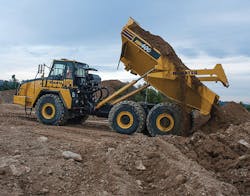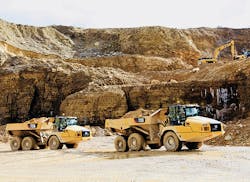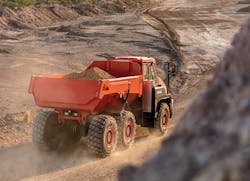Articulated dump trucks and rigid frame dump trucks sometimes seem so different, it’s hard to remember they’re both trucks. According to Aaron Kleingartner, marketing manager, Doosan Infracore North America LLC, the primary difference between articulated dump trucks and rigid frame trucks is the ability of an ADT to quickly and efficiently haul high volumes of material over rugged terrain for long distances. “ADTs provide operators with better off-road performance versus rigid frame trucks in mass excavation and earthmoving applications.”
“Look at the volume ADTs can carry,” says Mike Meshard, production application specialist for Caterpillar Inc. Their payload is what makes them attractive to quarries. Conversely, says his Cat counterpart Scott Thomas, production application specialist, rigid frame dump trucks are more useful where the payload is monitored.
Haul capacity aside, interjects Sebastian Witkowski, product marketing manager for Komatsu America, the primary difference between articulated and rigid trucks is their capability to operate in different terrain conditions.
Articulated trucks are used in all types of earthmoving applications, more notably those without dedicated roads or roads that are not maintained. “When the terrain is challenging or underfoot conditions are severe, customers count on Komatsu’s HM articulated truck model line,” says Witkowski. “From the 324 net hp HM300-5 to the 466 net hp HM400-5, both are all-wheel-drive and offer superior maneuverability to navigate any job site conditions. Depending on ground conditions, payload, and haul length, these trucks can traverse grades approaching 45%. Simply put, Komatsu’s articulated trucks go where rigid trucks cannot.”
In a more controlled environment where haul roads may exist, he says Komatsu’s rigid truck line for construction is “unrivaled. From the 514 net hp HD325-8 to the 724 net hp HD605-8, these trucks offer great climbing power, coupled with optimum traction and controllability for high production cycles. With McPherson Strut type independent suspension in the front and hydropneumatic suspension in the rear, Komatsu rigid trucks offer superior maneuverability and control over rough terrain and uneven road surfaces.”
It’s not just the surfaces they run on, but the slopes they traverse, adds Mark Shea, product consultant for John Deere articulated dump trucks. Rigid trucks run best on harder surfaces and finished roads, while ADTs can handle softer surfaces and slopes, as well as standing water. “They’re primarily used for removing overburden for mines, site development on commercial lots, roads, and subdivisions.”
On an ADT, all axles get power, so they’re good on slopes and in the muck. The differential locks every axle for power to every wheel. The rigid doesn’t have six-wheel-drive. “John Deere ADTs offer differential locks in every axle to maximize traction,” continues Shea. “With all three axles and all six tires getting power, John Deere ADTs are extremely well-suited for adverse off-road conditions, whereas a rigid frame haul truck doesn’t have six-wheel-drive and would get stuck easily.”
Shea contrasts the six-wheel-drive on an artic with the open diff in the rear on a rigid, which he likens to pickup truck style with power supplied only to the rear axle. “The artic has an articulated joint and a walking beam between the rear axles; the rigid has a straight frame. They drive and feel different.” For example, in the artic, he says, the operator sits close to the articulation joint, with the steering cylinders positioned behind him. In the rigid, the front axle is similar to a pickup truck where the front tires turn, tires are much larger, and the cab is very high. “It generally takes more training for the rigid.”
The six-wheel-drive artic oscillates and articulates for a reason, Thomas says: traction. It works well in soft conditions, slopes, mud, and water. But, he points out, it takes power and effort to move a machine with all six wheels. “If the road is smooth, it’s a waste of energy and money. It’s like rubber boots versus tennis shoes.”
Location, Location, Location
The weights and applications of the two trucks are so different, Shea reflects. “The artic is smaller: 20-ton to 60-ton. Rigid trucks are usually 50-, 60-, 70-ton and up.”
However, Kleingartner believes that the use of ADTs is less about size offerings and more about the ground conditions where the truck will be operated. “ADTs are commonly found on construction job sites in the early phases of site development, typically when ground conditions are not ideal. Compared [with] rigid frame trucks, ADTs are designed to quickly move large amounts of material—such as dirt, rock, sand, and gravel—in soft, wet, or adverse ground conditions.”
That’s why articulated trucks often come in “at the beginning of projects,” believes Meshard. On construction sites, he describes the artic as the “prime tool,” but if the site has a road and distance to travel, the rear-wheel-drive rigid is more cost- and fuel-efficient.
The choice depends on the length of the project and the mobility required, Thomas continues, explaining that contractors often rent the artic because they don’t need it as long as they’ll use a rigid…although he admits that there is some cross-over in the industry. In general, he says ADTs have broader appeal due to their versatility.
Shea concurs about the versatility of the articulated truck. “Each has its forte, but the artic is more versatile in where it can be used.”
Construction sites may offer more variety in site conditions, Shea reflects, but he thinks mining has more dedicated haul roads, which is one reason why rigid trucks are so often used there. Dedicated mining sites have something else, as well, he says: a higher degree of safety standards. Mining sites are regulated by the Mine Safety and Health Administration and must adhere to a high degree of safety standards. “The construction industry is not as heavily regulated.”
Some ADTs have front and rear limited-slip differentials and an inter-axle differential to improve truck performance by splitting power one-third to the front and two-thirds to the rear. A front-mounted turning ring and rear tandem bogie are two ADT features—a design feature for some brands—that maintain maximum traction and stability when traveling over very rough or soft terrain.
Doosan’s most recent update focused on the truck’s front suspension. The front suspension was updated to a hydro-gas, self-leveling system to provide superior performance and greater shock absorption, Kleingartner explains. Combined, these suspension system features allow for better driving comfort, especially when the truck is being driven while empty on a construction job site or at a mining operation. From a technical standpoint, the truck’s hydro-gas cylinders are connected to pressure accumulators, and the accumulators and hydraulic system replace the previous shock absorbers and rubber spring. The suspension of the updated DA30-5 includes a self-leveling feature and the ability to change the characteristics by adjusting the pressure.
Komatsu has also made improvements to automated braking and transmission efficiency that improve traction. Their Traction Control System allows for maximum machine performance in soft and slippery ground conditions. Witkowski says all Komatsu trucks, articulated and rigid alike, are equipped with the system as standard equipment. “The traction control system monitors wheel speeds and automatically engages and disengages wheel brakes individually, transferring power through the differential to the tire with the most traction. It operates without input from the operator and will not compromise steering performance, which one might experience with a differential lock system.”
Tech Talk
Today’s ADTs are equipped with on-board fleet tracking technologies, such as telematics, to track and report data in real time. Telematics systems can provide owners with a better understanding of how, when, and where construction equipment is being used. The location is provided in longitude and latitude, and the mapping software automatically changes to the closest address. “Telematics help operators make educated decisions,” states Shea.
In addition to tracking the physical machine location, many equipment manufacturers offer a geofence or time fence feature to help owners or fleet managers monitor unscheduled use and track machines in the event of theft or vandalism. With a geofence, owners can set virtual GPS boundaries; if a machine moves outside of the boundary, the owners are notified via email or text message. Additional relevant information conveyed by telematics includes payload—what you’re carrying, tire pressure and temperature, diagnostic codes, and utilization.
Many fleet tracking technologies use a terminal that is installed on the machine to gather and communicate data wirelessly via cellular or satellite service. The machine’s data is then sent to a website, where owners, operators, and equipment dealers can monitor the machine’s performance, operating hours, fuel usage, engine idle time, and work time. Owners and dealers can also monitor engine/hydraulic oil temperature and monitor fault and warning codes via a computer or cellular device.
In articulated dump trucks, the telematics system provides useful information such as the load count and volume (material) haul, Kleingartner explains. “Counters track the amount of volume the truck moves each day. The data can be aggregated to report on usage during a week or a month to track machine productivity.”
Fleet managers can use this information to make sure operators are optimizing the use of the trucks. Trucks sitting idle are hampering revenue. If a fleet manager can remotely assess how much a truck is sitting still and idling, and how much material the truck is moving while working, the fleet manager can determine if additional trucks are needed. The fleet manager can also remove a truck from a job site and still maintain acceptable productivity.
Both HM (articulated) and HD (rigid) truck lines are equipped with Komatsu’s remote equipment monitoring and management system, KOMTRAX. Standard on both types of trucks, Witkowski says it continuously monitors and records machine health and operational data. “This monitoring system is designed to allow owners and fleet managers access to machine performance data, including fuel consumption, utilization, and production.” It also provides metrics that can be used to lower owning and operating costs and is a no-cost feature that does not require a subscription.
For in-depth information about operation and production management, Komatsu’s Payload Meter system integrates with KOMTRAX. Payload tonnage is displayed on the machine monitor and is visible to the haul truck operator. An external display lamp mounted on the top of the cab communicates payload status to the loader operator, so the payload is always consistent and maximized. PLM data is transmitted by KOMTRAX and can be accessed via internet-enabled devices. Detailed data is stored in the truck’s controller and can be accessed via KOMTRAX, as well as directly downloaded from the truck to a PC.
For all the advances, maybe crews aren’t using technology. Cat’s Meshard thinks customers with rigid dump trucks focus on the payload. “They don’t use technology as much as we think. Technology is a bonus, but there’s not a huge number using it.”
Thomas supports him. “It’s like Android versus iPhone—do you use all the apps? We don’t use its full potential. You use it to manage how you do the job and you use the data to bid the next job.”
“We’re different,” continues Meshard. “We’re getting smarter about what technology makes sense. Core functions matter, but you can’t have technology on everything. There’s potential for failure, error codes, downtime…” He points out that a rigid dump truck is five to six times heavier than a semi and says it’s “hard to put delicate sensors on rugged equipment; the life expectancy of the components decreases drastically. This industry is built up around iron and in the end, it still has to be a truck and do its job. Key features are durability and reliability.”
Nevertheless, technology has its place, although he says that “good technology doesn’t get in the way.” Meshard believes that operators like the ability to pull data themselves. “For the operator, the most important [tech feature] is to reset the load counter at the beginning of a shift. We try to keep it simple and keep it about payload.”
Information such as location and hours and the ability to schedule PMs are welcome, but Thomas says Cat doesn’t want to distract the operator with “meaningless information.” He mentions one Carolina Cat customer who even disables cell phones in the cab.
Cat’s Advanced Productivity is a cloud-based system that lets a fleet manager know all of the important information, such as the truck’s location, speed, length of stops to load, and which operator is in the cab. “It’s rolling out on trucks with or without payload—both rigid and articulated,” says Thomas.
Coming Soon: New Attractions
Other things are also rolling out. Caterpillar expects to introduce “new stuff in 3–5 years,” says Thomas, foreshadowing “big improvements.” They introduced a new cab in 2017 for the 730, 735, and 745 that feature better visibility, a combined hoist-transmission lever, and Stability Assist—a sensor that monitors the cab and the bed to inhibit tipping while dumping.
Assisted Hoist neutralizes the transmission, brake, and engine RPMs at speeds below 2 miles per hour. These features let the operator concentrate on what he’s doing, Thomas explains.
Komatsu also focuses on the operator. Their rigid trucks feature a new ergonomic cab that provides the operator with a large, quiet, pressurized work environment with excellent visibility. “The cab itself is mounted on top of viscous dampers, which reduce mechanical vibrations and noise transmitted from the machine, maximizing operator comfort,” explains Witkowski.
John Deere’s E series trucks offer a cab that is the quietest in the industry, Shea claims. Nevertheless, he says Deere continues to make “incremental design changes” in their articulated dump trucks. One of those—the final Tier IV modification—resulted in certain customer applications seeing a gain of 10% fuel savings. Other improvements include auto-idle and auto shutdown, both of which save fuel burn and reduce engine hours. “It’s programmable, which customers like because it reduces unnecessary idle time, keeping the truck under warranty longer all while reducing overall operating costs.”
Popularity Contest
Deere’s most popular model is the 40-ton articulated dump truck. “It’s our flagship,” says Shea, although he is seeing “some transition to larger sizes” in recent years.
Popular ADT models at Cat continue to remain in a similar size range: the 30-ton 730 and the 45-ton 745 topping the list. “Larger contractors have larger excavators and can move more dirt,” says Meshard, “but the 30-ton works well for smaller contractors or job sites.”
Rigid frame dump trucks come in correspondingly larger sizes. Cat’s 70-ton 775 haul-truck/quarry-truck helps quarries reach their production targets without being too big, Thomas says. “It lines up well when loading equipment.” But the most popular is their 777 mining truck. “It’s very mobile for off-highway work,” he says, adding that one customer in Pennsylvania uses it for highway work as well.
Whatever size is chosen, one of the best ways to maximize productivity by reducing haul cycles is to match the truck with the proper loading equipment, such as an excavator or wheel loader, so equipment operators do not have to wait long between loads. “For example,” says Kleingartner, “if your job site calls for short hauls and you own a midsize crawler excavator, consider renting a 30-ton ADT. If you need to move larger volumes over long distances, a larger excavator paired with multiple ADTs could likely fit your requirements. Your dealership may have the right size wheel loader or excavator in their rental fleet if you do not have the corresponding loading equipment.” He estimates four to six passes to fill an ADT for most material hauling sites with good production.










